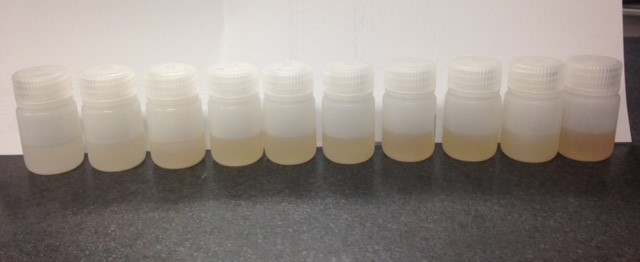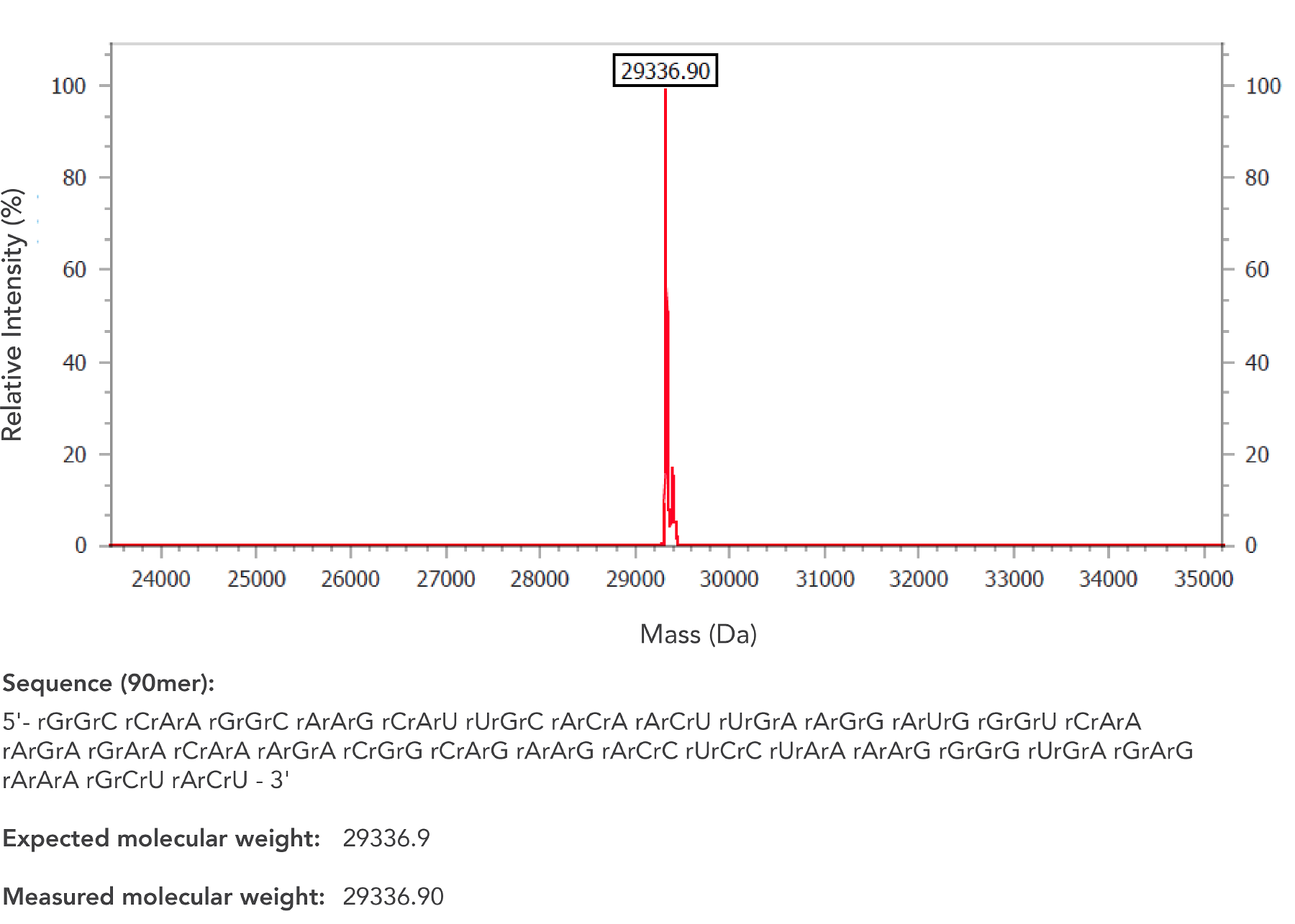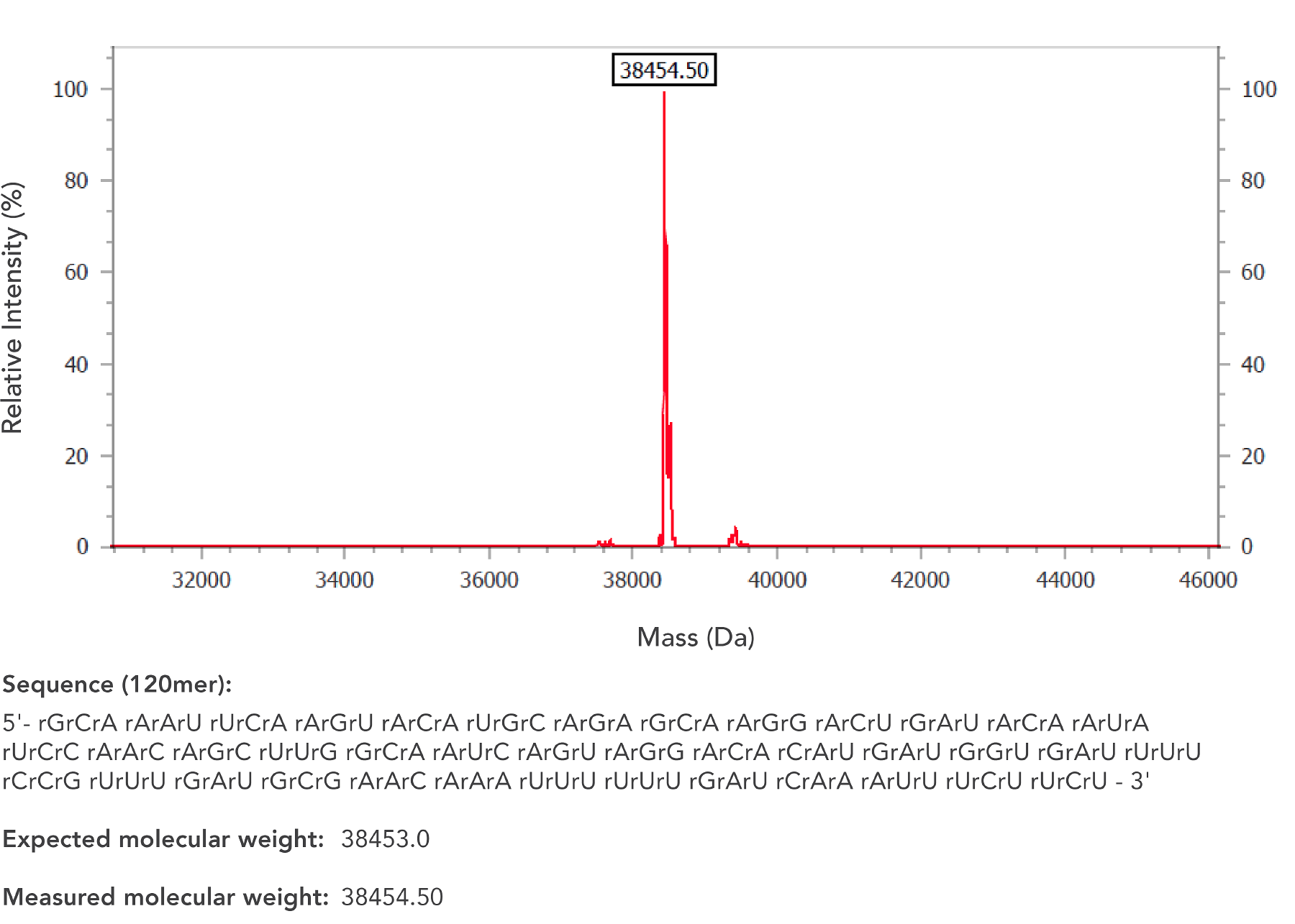Ultramer™ RNA Oligonucleotides
Single-stranded RNA oligos up to 120 bases, desalted and delivered dry in tubes
Ultramer RNA Oligonucleotides are manufactured using proprietary synthesis methods that deliver high-quality, long RNA oligos.
Ordering
- Each oligo is quality controlled by electrospray ionization mass spectrometry (ESI-MS)*
- Increase hybridization precision in your experiments using longer RNA oligos (60−120 bases)
- Supports RNA-related applications such as CRISPR and the generation of RNA controls and templates
- Receive guaranteed quantities of 4, 20, or 80 nmol
* With the exception of mixed base oligos, which could potentially represent multiple sequences and therefore cannot be evaluated by ESI-MS.
Ultramer RNA Oligos
Formulated to guaranteed quantities of 4, 20, or 80 nmol. Shipped dry, in tubes.
Product details
IDT has developed proprietary synthesis methods to deliver high-quality, long RNA oligos up to 120 bases. Ultramer RNA Oligos can be used in a variety of RNA-related applications. These include, but are not limited to:
- Single-guide RNAs (sgRNAs) for CRISPR
- Long RNAs for RNA structural studies
- RNA controls for PCR and qPCR
Ultramer RNA Oligos are desalted to remove small molecular impurities and formulated to 4, 20, or 80 nmol.
In addition, your oligos will be verified via ESI-MS* and quantitated by UV spectrophotometry.
*With the exception of mixed base oligos, which could potentially represent multiple sequences and therefore cannot be evaluated by ESI-MS.
Using the RNA Oligo Entry tool
- To enter individual RNA bases, insert "r" before the base (rA, rU, rC, rG)
- To enter individual 2'-O-Methyl RNA bases, insert "m" before the base (mA, mU, rC, rG)
- To quickly convert an entire oligo to RNA, enter your sequence as DNA using A, T, C, G and then click "Convert to RNA''. All bases in your sequence will be converted to RNA (rA, rU, rC, rG)
Product data
IDT employs proprietary equipment that permits rapid, high-quality synthesis of nucleic acids. However, this platform can be modified to a lower throughput mode that uses an "extra rich" synthesis cycle. Truncated byproducts of synthesis obscures mass spectra, making it difficult to deconvolute and identify the desired species. However, our mass spectrometry methods enable us to confidently QC your Ultramer RNA Oligos up to 120 bases (Figure 1,2). We provide ESI-MS quality documentation for every oligo we synthesize*. Overall, these improvements to our already established manufacturing methods allow you to acquire longer, purer oligos for your research.
* With the exception of mixed base oligos, which could potentially represent multiple sequences and therefore cannot be evaluated by ESI-MS.
Services
To provide you with an exceptional experience when using our custom oligos, we offer a range of custom purification, formulation, and quality control services. To learn more about available services for Ultramer RNA Oligos, click here.
Large-scale synthesis
Custom RNA oligos can be ordered in bulk with the same high purity you expect from IDT. For further information about our large-scale synthesis capabilities, click here.
GMP and OEM
If you require oligos that are ISO 13485:2016 certified, or if you are interested in our third-party manufacturing services, please click here.
Resources
Frequently asked questions
How do I convert my yield from nanomoles to ODs?
Calculating this conversion requires you to know the extinction coefficient for your sequence. With this, you can easily convert from your nanomole amount to ODs. To determine the extinction coefficient, you can analyze your sequence using IDT's free OligoAnalyzer™ Tool. Results from this analysis will also provide you with nmol/OD260 and µg/OD260 values.
Will you synthesize aptamers?
Yes. If you can provide the aptamer sequence(s), you can order directly from the IDT website.
To order online click on Custom DNA oligos, or if your sequence contains RNA bases, Custom RNA oligos.
Enter your desired scale, sequence, and purification.If you are ordering aptamers with a fixed sequence, IDT recommends HPLC or PAGE purification. For aptamer libraries containing random bases, IDT recommends standard desalt.
Will I lose more oligo when resuspending in polystyrene tubes compared with polypropolyene tubes?
All IDT oligonucleotides are shipped out in low absorption polypropylene tubes which can be used for long term storage without significant loss of material.
Why should I consider purification of my oligos?
Purification removes truncated products and other synthesis impurities. Our experience has shown that purifying an oligonucleotide that will be used in demanding applications saves both time and money in the long run. We recommend considering additional purification for any oligonucleotide that will be used for an application other than routine PCR, qPCR, or Sanger DNA sequencing.
As a general rule, IDT also recommends that any oligonucleotide longer than 40 bases should receive further purification. For questions, please contact us.
Why does the shipped quantity of product vary even for reorders of the same sequence?
Every IDT custom oligo is synthesized to order through a series of tightly controlled steps, including the coupling of the individual bases, cleaving the oligo from the solid support, desalting, and, if requested, purification. Each of these steps will result in a loss of final yield, which varies with each synthesis.
Due to this variation, IDT oligos are ordered according to the amount of starting material, also referred to as the scale. All custom oligos are assigned a minimum yield guarantee, but lot-to-lot variability in the final delivered quantity should be expected even when reordering the same sequence. For further questions about this subject, contact us.
Why are my oligos a yellow/brown color?
Customers who are new to working with large amounts of material are sometimes surprised when they see a yellow or brown discoloration to their oligos. If you have experienced this, do not worry. Color variation is normal in custom synthesis, especially as concentration increases. Importantly, IDT does not expect this to affect oligo function in our customers' experimental applications.

The image above depicts normal color variation as seen in oligo pools which are formulated to the same concentration (200 nmol oligos in 15 mL solution). In general, modified oligos at larger scales are more likely to display the variation seen above, while small-scale unmodified oligos (e.g., 25 nmol) tend to remain colorless in solution.
When will my oligos be shipped?
IDT oligos have various estimated ship dates depending on product type and composition. Oligos added to the shopping cart will show an estimated ship date for each line item.
Once the order is placed, this estimated ship date can be found on the order confirmation email as well as in the order history of your web account. You can find the order history at idtdna.com/site/orderstatus/orderstatus.
Select the order number you wish to review, and the status and estimated ship date of each line item will be shown.
IDT will email you a confirmation when your order has been shipped. This shipping confirmation will include the tracking number of the package, which you can use to monitor the status of your shipment. If you have additional questions about your order, please contact us.
When calculating the Tm of my oligo, should I only use the bases which are complementary to my target, or should I also include any sticky overhangs on the primer?
To determine the relative Tm of primers with non-complementary overhangs, only the complementary region should be taken into account.
You can obtain the Tm using the free, online OligoAnalyzer™ Tool.
What molar concentrations of oligonucleotide and salts are used to calculate the Tm reported on specification sheets?
The Tm value reported on our spec sheets uses a 25 µM oligonucleotide and a 50 mM salt concentration. It does not take into account dNTP or Mg2+ concentrations.
To get an accurate Tm for your specific application, all of these concentrations should be entered and adjusted to match the reaction conditions you plan to use.
The free IDT OligoAnalyzer™ calculates Tm for the concentrations you input.
What is the standard desalting procedure IDT uses for newly synthesized oligos, and what additional purification options do I have?
IDT uses a proprietary desalting technique that removes some truncation products and small organic contaminants from the synthesized oligonucleotide preparation. Removal of n-1mers produced during synthesis requires additional PAGE or HPLC purification.
PAGE is recommended for unmodified oligos >80−100 bases, while HPLC is the preferred method for oligos modified with either fluorescent dyes or attachment chemistries.
What is the stability of RNA vs. DNA?
RNA is inherently less stable than DNA due to its chemical structure. Additionally, RNases are more prevalent in standard laboratory conditions than DNases.
As even the slightest exposure to RNase can impact RNA stability, IDT has not performed rigorous long term stability studies for RNA.
What is the shelf life of my oligo?
The shelf life of an oligo is dependent on the temperature at which the oligo is stored and how the oligo is resuspended. Temperature is the more important of the 2 variables. Generally, oligos should be stored at –20°C. At this temperature an oligo has a minimum shelf life of 2 years, whether it is stored dry/lyophilized, in TE buffer, or in (non-DEPC treated) water.
Please see our DECODED™ article, Storing oligos: 7 things you should know, for data on oligonucleotide storage and a more thorough explanation.
What is the fidelity of your Ultramer™ oligonucleotide synthesis?
Standard DNA oligos have a coupling efficiency of 99.4%. Ultramer oligos have a 99.6% coupling efficiency. This increase results in higher fidelity synthesis. Regardless of synthesis choice, purification may be recommended for longer oligos based on your specific application.
For further information regarding Ultramer oligos, please see our Ultramer DNA Oligos catalog page.
What is the difference between scale and yield and why don’t I receive that full amount designated by the scale I order?
Oligo synthesis is accomplished through a series of steps, including coupling of individual bases, cleaving the oligo from the solid support, desalting, and if requested, purification of the oligo by HPLC or PAGE. No chemical reaction occurs with 100% efficiency, and, thus, each of these steps will incur a loss of final yield, which varies from specific sequence synthesis to synthesis.
Due to this variation, IDT custom oligos are ordered according to the amount of starting material used for the synthesis, referred to as the scale. While we cannot predict the actual final yield, we do guarantee a specific minimum yield for each oligo based on its sequence, starting scale, and the typical yield obtained under those specified conditions.
If you would like to know the minimum guaranteed yield for a specific oligo, simply add it to your Shopping Cart. The Shopping Cart provides you with the guaranteed minimum yield. If it is insufficient or excessive for your needs, simply edit the scale.
Please contact us if you have any questions about the yield you have received.
What is CE service?
What does OD260 stand for?
The heterocyclic ring structures in DNA and RNA absorb light with a maximum absorbance near 260 nanometers (nm). An OD260, or optical density 260, is defined as the amount of light at a 260 nm wavelength which will be absorbed by an oligo resuspended in 1 mL water and the concentration is read in a 1 cm quartz cuvette.
This method of measurement is considered the most accurate means of assessing the amount of oligonucleotide present following synthesis. The relationship between measured OD260, molar extinction coefficient (ε260), and oligonucleotide concentration is given as: OD260 = ε260 x concentration.
What are the base degeneracy codes that you use (e.g., R, W, K, V, S)?
For example, the letter Y is the symbol for an unspecified pyrimidine nucleoside and the letter R is for an unspecified purine nucleoside.
The letters used for ordering degenerate bases are as follows:
| R = | A,G |
| Y = | C,T |
| M = | A,C |
| K = | G,T |
| S = | C, G |
| W = | A,T |
| H = | A,C,T |
| B = | C,G,T |
| V = | A,C,G |
| D = | A,G,T |
| N = | A,C,G,T |
Be sure to use upper case letters (e.g., R, N, S) to denote mixed (degenerate, random, wobble) bases. Lower case letters are not recognized as they are used to denote certain modifications and RNA bases.
Want more information? Explore IDT's Mixed bases product page.
What are self- and homodimers, and how do I select primers to avoid these problems?
DNA and RNA oligonucleotides can form adverse secondary structures.
Self-dimers (also called homodimers) occur when some portion of an oligonucleotide is complementary to itself, resulting in an oligonucleotide molecule that can hybridize to another oligonucleotide molecule of the exact same sequence.
We recommend checking these interactions using the IDT OligoAnalyzer™ Tool, which is available for free in the online SciTools™ Web Tools.
What are RNA oligo chimeras?
RNA chimeras are oligos that contain both RNA and either DNA, 2'‑O‑methyl bases, or 2'‑O‑methoxyethoxy (MOE) bases.
What are DNA/RNA hybrid oligos used for and can IDT synthesize them?
DNA/RNA hybrids are commonly used in RNA silencing applications where DNA bases are placed on the ends of an siRNA molecule to decrease degradation within the cell. Other uses include RNase H-based applications for genotyping and SNP identification. DNA/RNA hybrid oligos are available from IDT via the RNA Oligos webpage.
When using the RNA Oligo Entry Tool, RNA bases should be represented with a lowercase r in front of them, with DNA bases represented by the base letter alone (for example, ACGTrArCrGrU).
GMP refers to products manufactured under ISO 13485: 2016 QMS. Purchaser is solely responsible for all decisions regarding the use of these products and any associated regulatory or legal obligations for their legal marketing.


